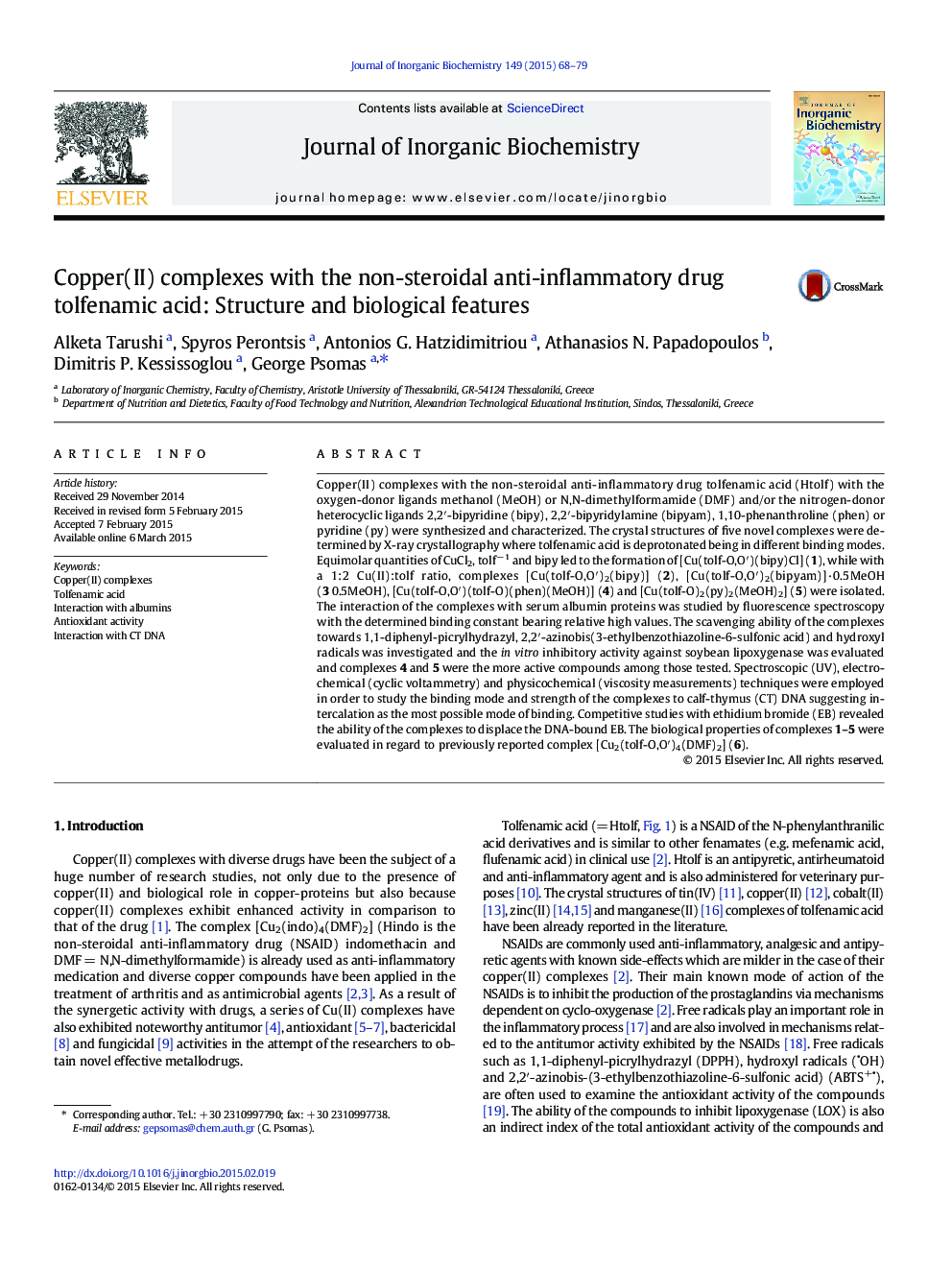| کد مقاله | کد نشریه | سال انتشار | مقاله انگلیسی | نسخه تمام متن |
|---|---|---|---|---|
| 1317116 | 1499438 | 2015 | 12 صفحه PDF | دانلود رایگان |

• Six copper(II) complexes with the NSAID tolfenamic acid were synthesized.
• The crystal structures of five Cu–tolfenamato complexes were determined.
• The complexes show significant radical scavenging and LOX inhibitory activity.
• The Cu–tolfenamato complexes can bind to human or bovine serum albumins.
• Intercalation is the most possible binding mode of the complexes to calf-thymus DNA.
Copper(II) complexes with the non-steroidal anti-inflammatory drug tolfenamic acid (Htolf) with the oxygen-donor ligands methanol (MeOH) or N,N-dimethylformamide (DMF) and/or the nitrogen-donor heterocyclic ligands 2,2′-bipyridine (bipy), 2,2′-bipyridylamine (bipyam), 1,10-phenanthroline (phen) or pyridine (py) were synthesized and characterized. The crystal structures of five novel complexes were determined by X-ray crystallography where tolfenamic acid is deprotonated being in different binding modes. Equimolar quantities of CuCl2, tolf− 1 and bipy led to the formation of [Cu(tolf-O,O′)(bipy)Cl] (1), while with a 1:2 Cu(II):tolf ratio, complexes [Cu(tolf-O,O′)2(bipy)] (2), [Cu(tolf-O,O′)2(bipyam)]·0.5MeOH (3 0.5MeOH), [Cu(tolf-O,O′)(tolf-O)(phen)(MeOH)] (4) and [Cu(tolf-O)2(py)2(MeOH)2] (5) were isolated. The interaction of the complexes with serum albumin proteins was studied by fluorescence spectroscopy with the determined binding constant bearing relative high values. The scavenging ability of the complexes towards 1,1-diphenyl-picrylhydrazyl, 2,2′-azinobis(3-ethylbenzothiazoline-6-sulfonic acid) and hydroxyl radicals was investigated and the in vitro inhibitory activity against soybean lipoxygenase was evaluated and complexes 4 and 5 were the more active compounds among those tested. Spectroscopic (UV), electrochemical (cyclic voltammetry) and physicochemical (viscosity measurements) techniques were employed in order to study the binding mode and strength of the complexes to calf-thymus (CT) DNA suggesting intercalation as the most possible mode of binding. Competitive studies with ethidium bromide (EB) revealed the ability of the complexes to displace the DNA-bound EB. The biological properties of complexes 1–5 were evaluated in regard to previously reported complex [Cu2(tolf-O,O′)4(DMF)2] (6).
The Cu(II) complexes with deprotonated tolfenamic acid in the presence of nitrogen- and/or oxygen-donor ligands exhibit noteworthy antioxidant activity and significant binding affinity for serum albumins and calf-thymus DNA.Figure optionsDownload as PowerPoint slide
Journal: Journal of Inorganic Biochemistry - Volume 149, August 2015, Pages 68–79